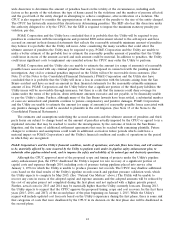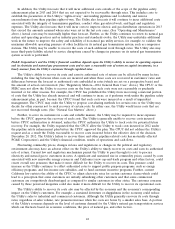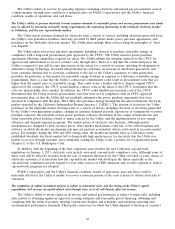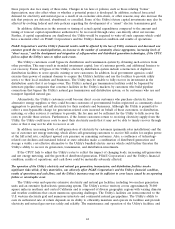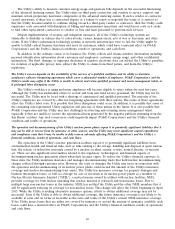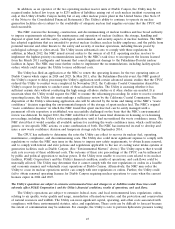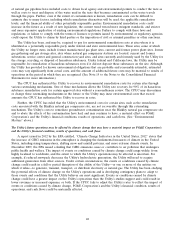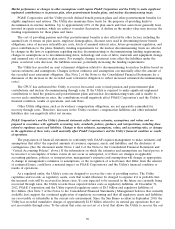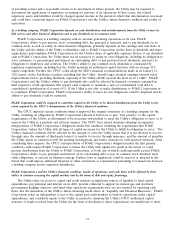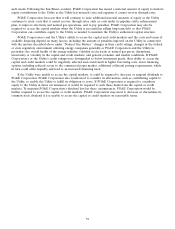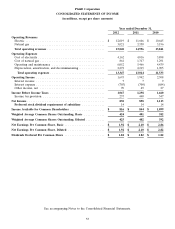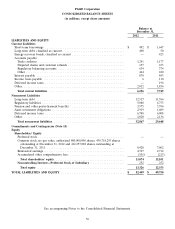PG&E 2012 Annual Report Download - page 53
Download and view the complete annual report
Please find page 53 of the 2012 PG&E annual report below. You can navigate through the pages in the report by either clicking on the pages listed below, or by using the keyword search tool below to find specific information within the annual report.The Utility is subject to penalties for failure to comply with federal, state, or local statutes and regulations. Changes in the
political and regulatory environment could cause federal and state statutes, regulations, rules, and orders to become more
stringent and difficult to comply with, and required permits, authorizations, and licenses may be more difficult to obtain,
increasing the Utility’s expenses or making it more difficult for the Utility to execute its business strategy.
The Utility must comply in good faith with all applicable statutes, regulations, rules, tariffs, and orders of the
CPUC, the FERC, the NRC, and other regulatory agencies relating to the aspects of its electricity and natural gas
utility operations that fall within the jurisdictional authority of such agencies. In addition to the NRC requirements
described above, these include meeting new renewable energy delivery requirements, resource adequacy
requirements, federal electric reliability standards, customer billing, customer service, affiliate transactions, vegetation
management, operating and maintenance practices, and safety and inspection practices. The Utility is subject to
penalties and sanctions for failure to comply with applicable statutes, regulations, rules, tariffs, and orders.
On January 1, 2012, the CPUC’s statutory authority to impose penalties increased from up to $20,000 per day,
per violation, to up to $50,000 per day, per violation. The CPUC has wide discretion to determine, based on the facts
and circumstances, whether a single violation or multiple violations were committed and to determine the length of
time a violation existed for purposes of calculating the amount of penalties. The CPUC has delegated authority to
the SED to levy citations and impose penalties for violations of certain regulations related to the safety of natural
gas facilities and utilities’ natural gas operating practices. Like the CPUC, the SED has discretion to determine how
to count the number of violations, but the delegated authority requires the SED to assess the maximum statutory
fine per violation. (For a discussion of pending investigations and potential enforcement proceedings, see MD&A
‘‘Natural Gas Matters’’ above.) There is a risk that the CPUC could delegate additional enforcement authority to its
staff or that legislation could be enacted to require the CPUC to further delegate enforcement authority.
In addition, the federal Pipeline and Hazardous Materials Safety Administration can impose penalties for
violation of federal pipeline safety regulations in amounts that range from $100,000 to $200,000 for an individual
violation and from $1 million to $2 million for a series of violations.
The Utility must comply with federal electric reliability standards that are set by the North American Electric
Reliability Corporation and approved by the FERC. These standards relate to maintenance, training, operations,
planning, vegetation management, facility ratings, and other subjects. These standards are designed to maintain the
reliability of the nation’s bulk power system and to protect the system against potential disruptions from cyber-
attacks and physical security breaches. The FERC can impose penalties (up to $1 million per day, per violation) for
failure to comply with these mandatory electric reliability standards. As these and other standards and rules evolve,
and as the wholesale electricity markets become more complex, the Utility’s risk of noncompliance may increase.
In addition, statutes, regulations, rules, tariffs, and orders, or their interpretation and application, may become
more stringent and difficult to comply with in the future. If this occurs, the Utility could be exposed to increased
costs to comply with the more stringent requirements or new interpretations and to potential liability for customer
refunds, penalties, or other amounts. If it is determined that the Utility did not comply with applicable statutes,
regulations, rules, tariffs, or orders, and the Utility is ordered to pay a material amount in customer refunds,
penalties, or other amounts, PG&E Corporation’s and the Utility’s financial condition, results of operations, and cash
flows would be materially affected.
The Utility also must comply with the terms of various permits, authorizations, and licenses. These permits,
authorizations, and licenses may be revoked or modified by the agencies that granted them if facts develop that
differ significantly from the facts assumed when they were issued. In addition, discharge permits and other approvals
and licenses often have a term that is less than the expected life of the associated facility. Licenses and permits may
require periodic renewal, which may result in additional requirements being imposed by the granting agency. In
connection with a license renewal for one or more of the Utility’s hydroelectric generation facilities or assets, the
FERC may impose new license conditions that could, among other things, require increased expenditures or result in
reduced electricity output and/or capacity at the facility.
If the Utility cannot obtain, renew, or comply with necessary governmental permits, authorizations, or licenses,
or if the Utility cannot recover any increased costs of complying with additional license requirements or any other
associated costs in its rates in a timely manner, PG&E Corporation’s and the Utility’s financial condition and results
of operations could be materially affected.
49




